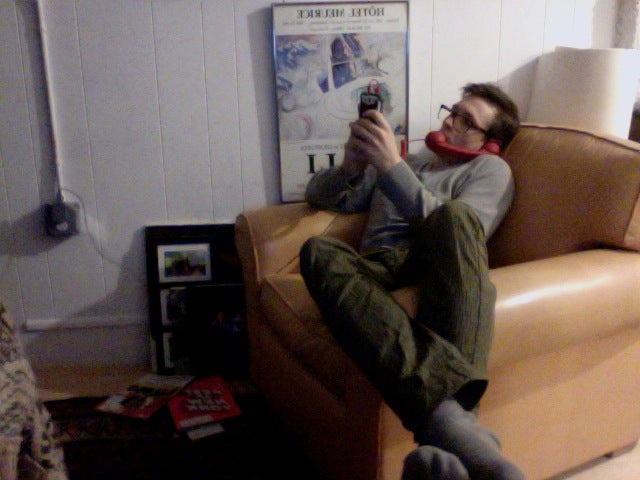
One man's trash is actually art to a lot of other people.
Last night, Bjorn Copeland—visual artist, musician, and one of the founders of massively influential experimental noise crew Black Dice—debuted new mixed-media works at Jack Hanley Gallery on Manhattan's Lower East Side. It's the third solo show the artist has presented there.
"The last time I showed here, it was in a group setting," Copeland said. "There was a lot of work crammed into the space. It definitely left me feeling like it was a cavernous space. I tried to work around that and push a lot of new ideas."
He certainly produced enough work to make the massive gallery feel full. The work ranged from large-scale visual collage cutups to combines to sculpture, all using found objects, detritus, the dregs of pop culture. A guitar amplifier oozed something from its speakers and input jacks. A strobe light flashed ceaselessly into a garbage can near a chair. What appeared to be vinyl appliques of advertisements were cut up and collaged into prismatic confusion. A propped-up box on a chair applied with reflective tape unfurled a string of lottery tickets to the ground, most of them scratched, a few near the bottom left unplayed, as if the gambler gave up. What appeared to be a grass patio umbrella shrouded in tarpaulin was bolstered on its base by vacuum hoses. The most fascinating piece was a massive, almost faceless portrait of a woman, spliced together with reflective tape. To try and discern how this piece was made was to feel as if you were falling into, and eventually, through it.
Though Copeland's work here is vibrant and saturated, it's hard to balance the ease of play with the sadness of consumer waste. This is of course the fault of the viewer—Copeland has found a way to deal with detritus in a productive way. And there's a resonance to this as well. The over-imposition of material preoccupation seems to stymie leisure. Being too caught up in "what else" can stifle the creative impulse. A sense of Dada, the imbalance of surrealist sculpture, and a tinge of post-pop green theory pervade the collection. Copeland is an intuitive and effortless artist, in concert with ideas of the moment but coming off as if he's light years ahead.
This is a kind of hallmark of his work as a whole, and the music of Black Dice: You can try and grab at familiar elements, but this is retroactively futile. In this work, it's best recognized from the beginning as not its disparate parts—this is all one tripped-out, lopsided mechanism, bowling forward without remorse.
The exhibition is on display until October 6.


